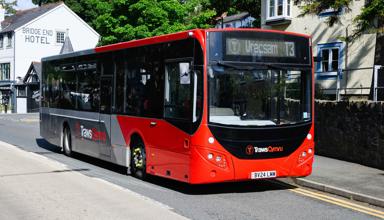Next week Members will debate the Climate Change, Environment and Infrastructure Committee's April 2025 report following its annual scrutiny of Transport for Wales (TfW). The Committee made 20 recommendations, all of which were either accepted or accepted in principle by TfW.
In its response to the Committee, TfW said it was “closer than ever to delivering our vision for truly integrated transport in Wales”.
Rail performance
The Committee noted that “the general direction of TfW’s rail performance is positive”. However, it said it expects “to see continuous improvement, particularly given the level of public investment in the service”.
TfW publishes various data including for ‘passenger time lost’ (PTL). PTL measures the percentage of services arriving within three minutes of the scheduled arrival time, applying a weighting to locations based on passenger volume – delays at busy locations have a greater impact on PTL. While performance overall appears to be improving, it is consistently better on the Welsh Government owned Core Valley Lines (CVL), compared to the wider Wales and Borders network.
Figure 1 - Passenger Time Lost (services arriving within three minutes of the scheduled arrival time, applying a weighting to locations based on passenger volume)
Source: Transport for Wales
Note – Each financial year consists of 13 ‘railway periods’. These are all 28 days except period 1 (starts 1 April) and period 13 (ends 31 March).
During the Committee’s scrutiny session, James Price, Chief Executive of TfW said the difference in performance was partially attributed to extreme weather events.
Figure 2 shows Senedd Research analysis of data from the rail regulator, the Office of Rail and Road (ORR) on the cause of rail cancellations for 2024. This shows TfW Rail had a higher percentage of cancellations attributed to external events impacting infrastructure compared to the GB, England and Wales and Scotland averages.
Figure 2 - Cancellations by cause 2024
Source: Office of Rail and Road
Note - This chart does not account for a small number of trains cancelled that are not attributed to the four responsibility categories presented.
In its report, the Committee highlighted that flooding remains a significant issue for Welsh rail services and called for TfW to work with landowners and Network Rail to develop better flood mitigation strategies in these areas.
TfW Rail also had a higher percentage of cancellations attributed to the operator itself as shown in Figure 2.
Analysis of ORR data on cancellations by station shows that, between August 2024 and August 2025, stations in Wales had the highest rate of cancelled services of any GB nation.
TfW publishes data for ‘on-the-day cancellations’. However the ORR publishes cancellations data that also takes into account service changes that have been included in a revised timetable – and therefore may not be appearing in operators’ cancellations scores.
The ORR produces an adjusted cancellations score incorporating services cancelled in advance. TfW’s adjusted cancellations score has generally been higher than the England and Wales average, although it did fall slightly below average in the two most recent rail performance periods (20 July – 16 August and 17 August – 13 September 2025).
Figure 3 - Adjusted cancellations score data, TfW rail v England and Wales average
Source: Office of Rail and Road
Note – Period 6 2025-26 data is provisional
Poor performance has previously been attributed to rolling stock issues including management of the fleet in light of ‘thermal incidents’ (i.e. fires that affected class 175 trains and led to the ORR issuing an improvement notice to TfW).
Issues with rolling stock again emerged during the Committee’s scrutiny session. Evidence from TfW outlined problems caused by delays in the delivery of new rolling stock from manufacturers. However James Price suggested the issue was not resulting in “cancellations to the extent seen in the past”. The Committee said it was “deeply concerned” by this and urged TfW to use “all options available to them to ensure that this last part of the contract is delivered on time”.
In September, TfW reported it had achieved the greatest improvement in punctuality among all train operators between April and June 2025 based on data collected using the ‘Time to 3 method’. This measures the percentage of station stops where trains arrived either early or within three minutes of their scheduled time.
Figure 4 - On time to 3
Source: Office of Rail and Road
Note – Period 6 2025-26 data is provisional
As of the most recent rail performance period, TfW has begun publishing ‘On time to 3’ data for both the CVL and the wider Wales and Borders network showing services on the CVL to be more punctual than the wider network (a 16.6% difference).
During the Committee’s scrutiny, James Price suggested that it is difficult to compare the performance of services on the CVL with that of rural lines with more infrequent services. The Committee has previously recommended TfW should publish data broken down by individual route level – a point that was accepted in principle by TfW, and has been supported by the Welsh Government and the new Chair of TfW’s Board.
In its report, the Committee once again called for tailored performance data to be published.
While punctuality and cancellations data continues to present a mixed picture, there are more positive trends in relation to customer satisfaction with rail services.
TfW had previously scored bottom (of all operators included) for overall passenger satisfaction in the independent passenger watchdog, Transport Focus’s, rail user survey.
In April 2023, Transport Focus called for TfW to “to urgently deliver a more reliable rail service after months of disruption for passengers”. It wrote to TfW asking it to develop an action plan for improvements around issues such as information provision and complaints handling.
Recent survey results have shown improvements in satisfaction, particularly on information provision, although satisfaction with value for money has declined.
Figure 5 - Transport for Wales overall passenger satisfaction and satisfaction with punctuality/reliability and frequency of services
Source: Transport Focus – Rail User Survey
Figure 6 - Transport for Wales passenger satisfaction with value for money, cleanliness and information provided during the journey.
Source: Transport Focus – Rail User Survey
Senedd Research analysis of TfW’s own customer satisfaction data also shows satisfaction levels have generally increased from 2024 onwards.
Bus
TfW’s role in buses is set for a big few years ahead as Wales moves towards the implementation of bus franchising.
In light of this, the Committee is concerned that Wales has experienced the slowest post-Covid recovery in bus passenger numbers in Great Britain. UK Department for Transport (DfT) data shows Welsh passenger numbers in the year to March 2024 were 78.3% of those in the year to March 2020, this compares to 92.5% in Scotland, 89.5% in England and 89.5% for Great Britain as a whole.
Since the Committee’s scrutiny of TfW, the Bus Services (Wales) Bill, which if enacted will see a move to franchising, has been introduced into the Senedd. The Committee published its stage 1 report on the Bill in July and while it supported the general principles it raised a number of issues. Stage 2 proceedings amending the Bill are due to take place on 22 October.
TfW will have primary responsibility for delivery of the Bill and bus reform. TfW has told the Committee:
As we prepare for bus franchising, we will be undertaking joint research and analysis with the Welsh Government which will help us further understand the factors contributing to a slower recovery of bus passenger numbers in Wales.
Active travel
The Committee welcomed TfW’s growing role in active travel but said this must not weaken local authority capacity. It also noted the findings of Audit Wales’ September 2024 report on active travel which concluded “the Welsh Government remains a long way from achieving the step change…intended through the Active Travel (Wales) Act 2013”.
The Welsh Government previously told the Committee “we are very poor” at evidencing rates of active travel and a number of Audit Wales’ findings relate to a lack of data and robust monitoring/ reporting arrangements. In evidence provided to the Committee the Welsh Government says the new “National Transport Survey Wales” will help address this. The recently published ‘Walking, wheeling and cycling annual report 2024-25’ suggests that the initial results of this survey will be available in Spring 2026.
Article by Francesca Howorth, Senedd Research, Welsh Parliament.












